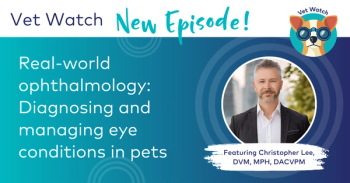
Canine keratitis: Ulcers to KCS (Proceedings)
The SCCED represents a specific unique type of corneal ulcer that is frustrating for veterinarians and clients alike. They are chronic, superficial, non-infected, and present with the patient minimally to severely painful. Most are characterized by a superficial erosion of the corneal epithelium with loose epithelial edges and variable corneal vascularization.
Spontaneous Chronic Corneal Epithelial Defect (SCCED/Indolent Ulcer/Recurrent Erosion)
The SCCED represents a specific unique type of corneal ulcer that is frustrating for veterinarians and clients alike. They are chronic, superficial, non-infected, and present with the patient minimally to severely painful. Most are characterized by a superficial erosion of the corneal epithelium with loose epithelial edges and variable corneal vascularization. Histopathology shows that in cases of SCCED the epithelium is poorly attached to the corneal stroma and that the normal epithelial architecture is lost. Epithelial to basement membrane and basement membrane to stroma adhesion complexes are absent or minimized in this condition. Additionally a thin, hyalinized, acellular zone develops between the epithelium and the underlying stroma. A SCCED should be suspected when a superficial ulcer persists for more than 7-10 days with no obvious cause or predisposing factor. Any breed can be affected, but most affected dogs are middle-aged or older. These dogs have no predisposing cause for a chronic ulcer and may or may not have had a known trauma.
Appropriate topical treatment should include a prophylactic antibiotic (e.g., neo-poly-bac or tobramycin) q 12 to q 8 hours and 1% atropine once or twice daily for comfort. Oral tramadol and a non-steroidal anti-inflammatory are also helpful to keep these patients comfortable. Topical hyperosmotic treatment with 5% sodium chloride ointment may facilitate healing in cases that have significant corneal edema associated with the lesion. Polysulfated glycosaminoglycans, epidermal growth factor, and fibronectin have also be used, but studies show that they do not increase the rate of healing beyond conventional medical and surgical treatments. Inhibition of destructive corneal enzymes with doxycycline and tetracycline has been shown to be ineffective in the canine patient.
Corneal epithelial debridement is a mainstay of treatment and can be repeated at 7-14 days intervals. Success rates after debridement alone averages 50%. Linear grid or superficial punctuate keratotomy are most often recommended to facilitate healing. Success rate after linear grid or punctuate keratotomy increases up to 80%. The result of these procedures is an increase the extracellular matrix components that are important in epithelial adhesion to the underlying The keratotomy procedures should only be performed on superficial, non-infected ulcers that have minimal edema. Success rate after complete superficial keratectomy is consistently 100%. This procedure works by completely removing the abnormal superficial layer of the cornea stroma. The linear grid and superficial punctuate keratotomies can be performed under general anesthesia, with sedation, or under topical anesthesia alone dependent upon the compliance of the patient and the experience level of the surgeon. The complete superficial keratectomy requires general anesthesia and an operating microscope for accurate dissection.
Corneal Stromal Ulcers
Ulcerative keratitis that extends into the corneal stroma normally is secondary to trauma or involves a microbial infection that initiated corneal destruction. Any visible defect in the corneal surface suggests stromal involvement. Most superficial ulcers are not visible with the naked eye, except some cases of SCCED. This being said, any ulcer that appears to involve the stroma should have a corneal cytology, culture and sensitivity evaluated. These tests should be performed prior to the application of fluorescein as which has been shown to inhibit bacterial growth.
Stromal ulcers may be progressive or non-progressive, the problem is telling the difference. Any stromal ulcer should be monitored closely for response to treatment to assure that it is not progressing. Medical intervention should be aggressive as these lesions, if progressive, are vision and globe threatening. Antibiotics can be chosen based on cytology and gram stain results and altered as necessary based on culture results. Topical atropine can be used to minimize ciliary spasm induced pain. Systemic antibiotics, anti-inflammatories, and pain medications are all recommended as well. If stromal melting is present, antibiotic and anti-collagenase/anti-protease therapies should be given every 1-2 hours. Surgical intervention to provide tectonic support is recommended in stromal lesions that are greater than 50% of the corneal depth. Tectonic support can be via conjunctival graft, corneal conjunctival transposition, amniotic membrane graft, or synthetic membrane graft. Tissue adhesives have also been used in the treatment of stromal ulcers. The procedure can be done under topical anesthesia, with sedation, or under general anesthesia dependent upon the compliance of the patient. The cornea is dried with a cotton swab or warm air and a very thin layer of adhesive is applied to the cornea. The adhesive needs 15 to 60 seconds to dry without allowing blinking of the lids. If the application of adhesive is too thick it can cause irritation or it can be sloughed prematurely. Tissue adhesive use in cases of descemetoceles is not recommended due to the potential for ocular toxicity.
Corneal Endothelial Dystrophy
Corneal endothelial dystrophy is caused by a degeneration of the corneal endothelial cells and results in progressively expanding and worsening corneal edema. The edema causes the cornea to have a bluish white appearance, normally without corneal vessels or conjunctival hyperemia. The primary differential diagnosis for corneal edema is a corneal ulcer, uveitis, or glaucoma, each of which is usually easily distinguished from this condition. Endothelial dystrophy is slowly progressive, typically beginning in the lateral cornea and progressing to involve the entire cornea of middle-aged or older dogs. There is breed predilection for this condition in the Boston terrier and Chihuahua, but it can be seen sporadically in just about any dog breed. It is non-painful in the early stages. Advanced endothelial dystrophy will cause fluid pockets or bullae to form in the cornea. These bullae can rupture causing ulcerative keratitis. Medical therapy of the condition is palliative with a hyperosmotic 5% sodium chloride ointment used BID-QID to minimize edema. The hyperosmitics may decrease the extent of bullae formation, but will not give dramatic clearing of the cornea. Topical antibiotics or atropine are indicated if the cornea is ulcerated. Conjunctival hyperemia can be pronounced in some affected dogs, and the cause is not clear. If the eyes are especially irritated and there are no ulcerations, topical steroids can be used cautiously. In cases where the edema is extreme or where recurrent ulcerations are occurring thermo- or photo-keratoplasty can be performed. These procedures will not clear the cornea substantially but will result in enough scarring to prevent progressive edema and the pain associated with recurrent ulcers. The technique involves making multiple superficial corneal stromal burns with an ophthalmic thermocautery unit or a CO2 laser. Surgical discretion is advised because the cornea can "melt like butter" under the heat of the cautery unit or laser. Penetrating keratoplasty (or corneal transplant) can be performed in selected instances.
Degenerative Keratopathy
Corneal degeneration refers to lipid or calcium deposits, or both, in the corneal epithelium or stroma secondary to pre-existing ocular disease. Prior disease may include corneal ulceration, uveitis, or phthisis bulbi. In contrast to corneal dystrophy, corneal degeneration is often unilateral. The degenerative area of cornea is opaque, roughened, and there is frequently disruption of the epithelium. Concurrent inflammation, vascularization, and pigmentation are common. Lamellar keratectomy is the preferred treatment if the animal is in pain or visually impaired, but the condition may recur. In some instances, a topically applied chelating agent (e.g., 0.4 to 1.38% EDTA solution) may be beneficial in dissolving calcium deposits when used either alone or in combination with keratectomy. Chemical debridement of the deposits has also been shown to be effective in improving or resolving the condition. In cases where the epithelial layer has been breached, a trichloroacetic acid debridement can remove the degenerative corneal tissue and allow for healing. Some scarring can occur, but the corneal opacities are normally less than what was present with the degeneration itself.
Punctate Keratitis
This is a relatively uncommon condition for which the Dachshund appears predisposed. Punctate keratitis appears to be immune-mediated, and this is the one instance of corneal ulceration where topical steroids are indicated. Affected eyes usually have multifocal punctate corneal opacities that retain fluorescein stain, and one or both eyes can be affected. Topical cyclosporine or tacrolimus and corticosteroids are used to treat and control the signs of this disease.
Keratoconjunctivitis Sicca (KCS)
KCS, or dry eye, is common in the dog and relatively uncommon in other domestic animals. It represents a quantitative tear abnormality with deficiency of aqueous tears. Clinical signs can include blepharospasm, mucoid to mucopurulent ocular discharge, conjunctival hyperemia, and varying degrees of corneal vascularization, pigmentation, and scarring. Corneal ulcers can develop concurrent with KCS. In chronic or refractory cases, blindness is possible from severe corneal scarring or pigment deposition, or progressive corneal ulceration. KCS is most often a disease of middle-aged or older dogs that develops gradually in one or both eyes, but it can occur acutely and in young dogs. Commonly affected breeds include the American Cocker Spaniel, West Highland white terrier, Yorkshire terrier, English bulldog, Shih Tzu and Cavalier King Charles Spaniel, but any breed can be affected.
The Schirmer tear test (STT) is used to confirm the diagnosis. The STT-1 is performed prior to application of Fluorescein stain or topical anesthetics to the eye. The STT-1 measures both reflex and basal tear production. The normal STT-1 value is >15 mm of wetting after one minute for dogs. The significance of STT-1 values between 10-14 mm per wetting minute should be interpreted based upon the clinical signs. Values of <10 mm per wetting minute indicate clinical KCS. Cats are an exception to this latter point. Low STT-1 values are common in cats with non-inflamed and otherwise normal eyes. Therefore, the difference in STT-1 values between the eyes may be more important for interpretation in cats than the absolute value. A STT should be performed on any pet with an irritated eye, ocular discharge, or corneal disease of undetermined cause.
Canine KCS is most often due to immune-mediated disease directed against the orbital and nictitans lacrimal glands. Histopathology reveals lymphocytic-plasmacytic glandular infiltrates and this is the basis for the use of immunomodulating treatments. Other causes of KCS include lacrimal gland aplasia or hypoplasia, infection (e.g., distemper virus), neurogenic (e.g., trigeminal neuropathy), neuroparalytic (e.g., facial neuropathy), trauma, iatrogenic (e.g., nictitans gland excision), and drug-induced. Drugs with potential to reduce tear production include topical or systemic atropine, oral sulfonamides, etogesic, and certain glaucoma drugs (e.g., timolol). Conditions such as diabetes mellitus, hypothyroidism, and dehydration, may also reduce tear production. Topical and general anesthesia reduces tear production and pets under general anesthesia should have an artificial tear ointment applied to the eyes. Tear production can be decreased for as long as a week after general anesthesia. Application of an antibiotic ointment during anesthesia is not advised because of greater potential allergic reactions (especially in cats). Effective dry eye treatment depends on an accurate assessment of the cause, correction of complicating factors (e.g., lagophthalmos), and owner compliance. Initial treatment usually requires a combination of tear stimulants and lubricants, topical antibiotic, and possibly topical steroid. Treatments are tapered or modified depending on patient response.
Lacrimomimetics are agents that imitate natural tears or tear components and are synonymous with artificial tears. Normal tears are trilaminar with lipid, aqueous, and mucin components, and each layer has a specific function. Artificial tear preparations are formulated to simulate one or more components of the tear film, and most are available over-the-counter as solutions, gels, or ointments. A combination of products can be helpful in severely affected patients, in part, because of different ocular retention times. Artificial tear solutions more closely resemble aqueous tears and are helpful for loosening ocular mucous and debris, but they have the shortest retention times. Gels and ointments have substantially longer contact times, thus providing justification for combination treatment. Mucinomimetic agents are those that simulate tear mucin. They tend to be viscous and consist of polymers such as carboxymethylcellulose, hydroxypropyl methylcellulose, sodium hyaluronate. Artificial tear ointments usually combine petrolatum and mineral oil. The ointments simulate tear lipid, have the longest retention times, and help to prevent evaporation of tears. Most artificial tear preparations are intended for repeated daily application and are well tolerated. However, pets can develop sensitivity to preservatives contained in these preparations, and preservative-free preparations are preferred in these instances.
Lacrimostimulants are agents that increase or stimulate natural tear production. Cyclosporine and tacrolimus inhibit T-cell activation and improve natural tear production by a minimizing the T-cell attack on the lacrimal gland and by directly lacrimal stimulation. They are presently the most effective treatments for canine KCS. Cyclosporine is commercially available as a 0.2% ointment (Optimmune) but can be compounded in stronger concentrations as a 1% or 2% drop or ointment. Caution should be taken with the use of 2% cyclosporine as one study showed systemic immunosuppression when used in "small dogs". Tacrolimus is usually compounded as a 0.02% or 0.03% drop or ointment. Either drug can be formulated in an oil or aqueous base. Aqueous-based formulations are easier for owners to apply and may be less irritating than oil-based preparations. Which drug to use depends on personal preference, prior treatment, and severity of the KCS. A stronger formulation is indicated in patients unresponsive to the 0.2% ointment. There is more data on cyclosporine than tacrolimus, but in one study, almost 50% of dogs that were some non-responsive to cyclosporine improved after treatment with tacrolimus. The frequency of application for either drug is typically twice daily, but treatments can be increased to three times daily if response is inadequate. Up to three months of treatment can be required to see the full extent of the response to topical immunomodulators. Normally an improvement in clinical signs is rapid, but three months of treatment is recommended prior to declaring medical failure. Both drugs appear to improve patient comfort and reduce corneal inflammation, scarring, and pigment. In pets that do not respond with improved tear production, continued treatment is still advised to prolong vision and comfort. Some ophthalmologists advocate combination treatment with cyclosporine and tacrolimus in patients that respond inadequately to either drug alone, but such treatment is controversial.
Pilocarpine has historically been used for lacrimostimuation. Two percent pilocarpine at a dosage of 1-2 drops/25 pounds body weight BID in the food is a good starting dose. The dosage is gradually increased until a response is observed or signs of toxicity develop. Toxic signs include salivation, bradycardia, vomiting, or diarrhea. Pilocarpine is mentioned here for completeness, but since cyclosporine was introduced, it has declined in popularity.
Judiciously applied topical corticosteroids are beneficial for many dry eye patients to reduce conjunctival and corneal inflammation and corneal vascular infiltrates. However, pets with KCS are at greater risk for corneal ulceration, and caution is advised, especially in pets with negligible tear production. Neo-poly-bac with hydrocortisone ointment is a good first choice because the steroid is relatively mild but sufficiently strong to be of benefit.
Natural tears have antibacterial properties, so it is not surprising that bacterial infections are common with dry eye. Cyclosporine treatments have been shown to decrease ocular bacterial infection because of improved tear production. Topical and or systemic antibiotic treatment is indicated in many KCS patients.
Tear production should be checked two weeks after initiating treatment and periodically thereafter. Cyclosporine or tacrolimus treatments are modified depending on patient response. In dogs with restoration of normal tear production (>15 mm/minute), it may eventually be possible to reduce cyclosporine or tacrolimus to once daily and discontinue other topical treatments. Parotid duct transposition surgery should be considered for dogs that have not responded months of appropriate treatment.
Parotid Duct Transposition
Parotid duct transposition (PDT) surgery should be considered in dry eye patients that are unresponsive to treatments, which remain uncomfortable, or experience recurrent corneal ulcers. Saliva is similar enough in composition to tears to be an acceptable substitute. Possible complications of PDT surgery include mineral precipitates on the cornea and eyelids, chronic epiphora, facial dermatitis, and post-operative stenosis of the parotid duct. Mineral precipitates are the most common complication but can usually be managed with daily cleaning of the eyelids and periodic removal from the corneal surface with a cellulose surgical spear (e.g., 2-3 times annually). Topical 1.38% EDTA solution several times daily may be helpful in reducing deposits. Dietary management can also be helpful, and diet low in mineral content is advised for problem cases.
Newsletter
From exam room tips to practice management insights, get trusted veterinary news delivered straight to your inbox—subscribe to dvm360.






